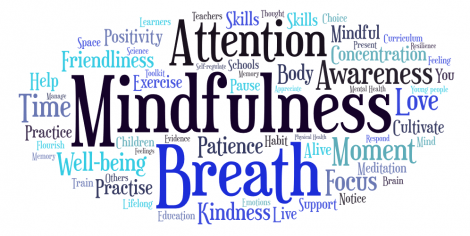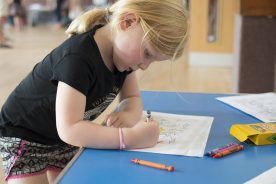Mindfulness
Well-being and learning can’t be separated. One supports the other. Well-being underpins the way children feel about themselves and how they relate to others.
We all have mental health, it is just as important as our physical state. Everyone has it and we need to take care of it, no matter what age. Mindfulness is one way to start doing this; training for the mind.
Mindfulness
Well-being and learning can’t be separated. One supports the other. Well-being underpins the way children feel about themselves and how they relate to others.
We all have mental health, it is just as important as our physical state. Everyone has it and we need to take care of it, no matter what age. Mindfulness is one way to start doing this; training for the mind.
Mindfulness is . . .
Paying attention to things as they happen
A life skill
Evidence based
Why . . .
Enhance well-being, feel happier and calmer
Help concentrate and therefore learn better
To get on better with others
Help cope with stress and anxiety
Calm skies offers . . .
1:1 sessions
Small group focused work
10 Session .b curriculum for 11-16 year olds
12 Session Paws b curriculum for 7-11 year olds
Why
- Enhance self-awareness
- Improve relationship skills
- Increase attention and concentration
- More energy
- Increase sense of calm
- Enjoy better health and sleep
- Develop empathy
- Learn how to relax and regulate emotions
- Improve decision-making skills
- Increase self-esteem and optimism
- More control over immediate emotional responses
- Recognise worry and manage difficulties
- Cope with exams and academic stresses
- By developing a more mindful awareness helps children to appreciate what is going well and flourish
Mindfulness is …
Bringing your attention to the present moment with openness, kindness and without judgement. Simply focusing your attention to the here and now, rather than thinking about the past or worrying about the future.
Mindfulness Vs. Meditation
These two terms are often thrown about together so the difference is that meditation is the formal practice of mindfulness, often referred to as training for the mind. We meditate to exercise the mind. The informal practice of mindfulness is bringing our attention into our daily life whenever we can.
How does it work? (The science bit that is well worth a read!)
We can train our mind to change our brain. By training our mind, just like we train our muscles, allows for significant and positive shifts in our brain.
In this way practising mindfulness is
By practising mindfulness regularly will start to create new pathways in the brain that will change the way the brain works resulting in improved mental health, physical health and well-being.
Click here for a great poster outlining the different areas of the brain that can be developed and work as a team during mindfulness practice.
Is it difficult?
At

How does it work?
(The science bit that is well worth a read!)

We can train our mind to change our brain. By training our mind, just like we train our muscles, allows for significant and positive shifts in our brain.
In this way practising mindfulness is
By practising mindfulness regularly will start to create new pathways in the brain that will change the way the brain works resulting in improved mental health, physical health and well-being.
Click here for a great poster outlining the different areas of the brain that can be developed and work as a team during mindfulness practice.
Is it difficult?
At
What we do at Calm Skies
We offer several options and are completely flexible as to the needs of the individual person, family or school. We are trained to deliver both .b (Read More) and Paws b (Read More) curriculums to whole classes or small groups if more appropriate. These programs were created by classroom teachers and mindfulness experts with the aim of giving young people mindfulness as a life skill. It is taught with striking visuals, film clips and activities that bring mindfulness to life without losing the expertise and integrity of classic mindfulness teaching. In addition, all of the Yoga sessions incorporate both formal and informal mindfulness practices throughout.
Quick and Easy Mindful Activities to try today
What we do at Calm Skies
We offer several options and are completely flexible as to the needs of the individual person, family or school. We are trained to deliver both .b (Read More) and Paws b (Read More) curriculums to whole classes or small groups if more appropriate. These programs were created by classroom teachers and mindfulness experts with the aim of giving young people mindfulness as a life skill. It is taught with striking visuals, film clips and activities that bring mindfulness to life without losing the expertise and integrity of classic mindfulness teaching. In addition, all of the Yoga sessions incorporate both formal and informal mindfulness practices throughout.
Quick and Easy Mindful Activities to try today
So what is mindfulness NOT?
You may have heard of the word ‘mindfulness’ being thrown around a great deal recently, both in the media and amongst friends and family and not always in a positive light. The overuse and sometimes misuse of the word can often leave us feeling confused, perhaps unsure as to what it is all about and a sense of it being a wishy-washy, quick-fix and quite frankly, mystical concept.
It is not about clearing the mind of all thoughts.
It is not about just having positive thoughts.
It is not about quietening the mind.
It is not linked to any religious practice or belief.
It is not just about relaxing.
It is not a magical or mystical concept.
So what is mindfulness NOT?
You may have heard of the word ‘mindfulness’ being thrown around a great deal recently, both in the media and amongst friends and family and not always in a positive light. The overuse and sometimes misuse of the word can often leave us feeling confused, perhaps unsure as to what it is all about and a sense of it being a wishy-washy, quick-fix and quite frankly, mystical concept.
It is not about clearing the mind of all thoughts.
It is not about just having positive thoughts.
It is not about quietening the mind.
It is not linked to any religious practice or belief.
It is not just about relaxing.
It is not a magical or mystical concept.
Useful resources
The Science of Mindfulness | Mother Earth Living
Mindfulness for Children (Simon and Schuster, 2018) by Tracy L. Daniel is a guide for explaining and practicing the art of being present and the positive benefits for children learning to be mindful. Learning mindfulness enables children to deal with their emotions in a balanced healthy way.
NBA coach Phil Jackson discussing how and why he integrated
mindfulness into his coaching plan for the Chicago Bulls and
LA Lakers.
See a TEDx Talk by Richard Burnett on Mindfulness in Schools
Research
- Mindful Schools carried out several research papers on the effectiveness of mindfulness within schools in the US.
See www.mindfulschools.org for more details.
- The Mindfulness in Schools Project (MiSP)
are an organisation leading the way in the UK for training and research into the effectiveness of mindfulness practices within the school setting.
See www.mindfulnessinschools.org for more details.
- Mindfulness for Children
are aUS based organisation who have studied the benefits of mindfulnessamongst children.
See www.mindfulnessforchildren.org for more details.
- Be Mindful is another great UK based group that looks into the positives of regular mindfulness
amongst young people.
See www.bemindful.co.uk for more details.




